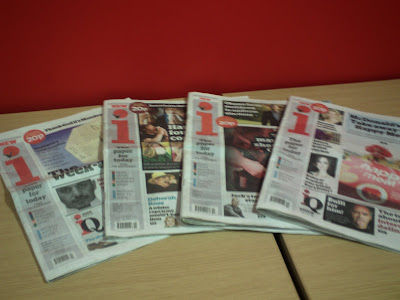
Well the new i newspaper is no 'nine days wonder'. It has completed its second week of trading. The 20p priced paper is competing against free newspapers such as Metro up and down the country and the free Evening Standard in London.
Of course it is early days yet but it has got off to a good start.
It got me thinking about the origin of the expression 'nine days wonder' which we can use in conversation about new products etc. in sales.
However we use it usually to refer to a short and not particularly successful project or life cycle.
This week I came across a plaque in Bishopsgate, in the City London (financial district) which explained the derivation of the expression “a nine days wonder”. It refers to one William Kemp (died 1603) who was an English actor and dancer specializing in comic roles.
He was best known for having been one of the original players in early dramas by William Shakespeare.

In February and March of 1600, he undertook a project to raise his profile which was waning. He would later call the publicity stunt his "Nine Days Wonder", in which he morris danced from London to Norwich (a distance of over a hundred miles) in a journey which took him nine days spread over several weeks, often amid cheering crowds especially at his arrival in Norwich.
Later that year he published a description of the event in order to prove to doubters that it was true. I guess celebrity culture in the entertainment industry has a long pedigree.
Likewise, no company’s products, policies or forward planning can remain static. The needs of consumers are constantly evolving, technological changes will make many existing and successful products obsolete, competitors enter successful markets and economic factors can modify consumer purchasing behaviour.
Product planning is vital so that products are continuing to meet changing consumer needs. The sales results are monitored against forecasts.
New marketing ideas can be evaluated and introduced if they are acceptable and todays profits can finance tomorrow’s new products. So let's look at the topic of Product life cycles.
At the
development stage of the product life cycle, research has usually been undertaken and products designed. Prototypes are originated and tested, financial and human resources are allocated to the product’s’ development. Investment is relatively high and income is zero. Many product ideas are eliminated at this stage.
In this week's news,probably the most remarkable eaxample of a product in development stage is the new artificial retina implant. The trial was conducted in Germany using a device made by Retinal Implant.
UK trials are due for next year at the Oxford Eye hospital and Kings College London.
The launch of the i newspaper which is at its
introduction stage of the life cycle where considerable marketing communications effort is spend on promotion as Bill boards and poster on the sides of London’s Red Buses attest. Income at this stage is minimal but future profits should offset these early losses if all goes well.
Meanwhile again in the newspaper world the Times on-line has being charging for readers going beyond the opening page. There is considerable debate about the type of subscribers they have captured but it will be interesting to see whether they can buck a trend of free online news services.

Next are products and services which appear to be in the
growth stage of the product life cycle. By this time, the investments in the development and introductory phases should have begun to pay off. The cumulative effect of the promotion mix should stimulate an upward growth for the product. Profits will be at their highest during this stage, paying payback of a high proportion of the preceding investment.
If the product is proving successful, competitors will begin to enter the market. These are often called “Me toos”. The IPod now is in its ninth year. It has spawned the mini and the Nano perhaps suggesting it is in a later part of the growth stage moving into maturity.
In the
maturity stage of the life cycle there are generally a large number of competitor and promotional expenditure is used to defend market positions sales start to peak out. Mobile phones would be a good example for the UK.
Saturation and decline stage: As the market becomes saturated a downward trend in sales and market size will occur and profits will markedly shrink at this stage. The product is approaching its period of phasing out.
A sad example to me of this is General Motors announcement to phase out one of the iconic muscle car brands – the Pontiac. The Pontiac lasted 84 years. In 1968, Pontiac’s sales reached 1 million – a feat which was never to be repeated in its history.
Similarly Sony has decided to no longer produce the Walkman cassette players after a 31 year life cycle. Launched in July 1979 it was derided as a fad with only 3,000 units sold in the first month. It subsequently grew to 400 million sales. Production ceases in Japan this month and the production in China will also once existing orders in Asia & Europe are met.

POSTSCIPT
The ‘ i newspaper’ has a weather section (our English obsession with matters meteorological). It covers a weather outlook in a city by city guide. It has a section on Norwich with an illustration of key buildings in the city including the cathedral that William Kemp would have recognised.
Click for course programme for TACK’s Marketing for Business Professionals programme.












































